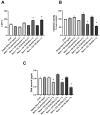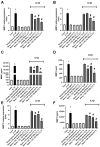Chondroitin Sulfate Nanovectorized by LC-PUFAs Nanocarriers Extracted from Salmon (Salmo salar) by Green Process with Decreased Inflammatory Marker Expression in Interleukin-1β-Stimulated Primary Human Chondrocytes In Vitro Culture
- PMID: 39728145
- PMCID: PMC11676681
- DOI: 10.3390/md22120571
Chondroitin Sulfate Nanovectorized by LC-PUFAs Nanocarriers Extracted from Salmon (Salmo salar) by Green Process with Decreased Inflammatory Marker Expression in Interleukin-1β-Stimulated Primary Human Chondrocytes In Vitro Culture
Abstract
Chondroitin sulfate (CS), a glycosaminoglycan, supports health through various physiological functions, including tissue protection, bone growth, and skin aging prevention. It also contributes to anticoagulant or anti-inflammatory processes, with its primary clinical use being osteoarthritis treatment. This study presents the results of the valorization of lipids and CS, both extracted from salmon co-products through enzymatic processes. The polar lipids, naturally rich in long-chain fatty acids (docosahexaenoic acid DHA C22:6 n-3 and eicosapentaenoic acid EPA C20:5 n-3), and the CS, primarily located in the nasal cartilage, were separated and concentrated before being characterized using various techniques to determine functional and lipid composition. These compounds were then used to formulate liposomes of 63 to 95 nm in size composed of 19.38% of DHA and 7.44% of EPA and encapsulating CS extract with a Δdi-4S/Δdi-6S ratio of 0.53 at 2 weight masses (10-30 kDa and >30 kDa) or CS standard all at two different concentrations. Liposomes were tested on human chondrocytes in inflamed conditions. Thus, compatibility tests, the expression of various inflammation markers at transcriptional and molecular levels, nitrites, and the amount of collagenase produced were analyzed. The results showed that CS, in synergy with the liposomes, played a positive role in combating chondrocyte inflammation even at a low concentration.
Keywords: Salmo salar; anti-inflammatory; chondroitin sulfate; encapsulation; enzymatic hydrolysis; liposome; phospholipid.
Conflict of interest statement
The authors declare no conflicts of interest.
Figures







Similar articles
-
Encapsulation of Salmon Peptides in Marine Liposomes: Physico-Chemical Properties, Antiradical Activities and Biocompatibility Assays.Mar Drugs. 2022 Mar 31;20(4):249. doi: 10.3390/md20040249. Mar Drugs. 2022. PMID: 35447922 Free PMC article.
-
Eicosapentaenoic acid and docosahexaenoic acid reduce interleukin-1β-mediated cartilage degradation.Arthritis Res Ther. 2010;12(6):R207. doi: 10.1186/ar3183. Epub 2010 Nov 8. Arthritis Res Ther. 2010. PMID: 21059244 Free PMC article.
-
Interactions between dietary docosahexaenoic acid and other long-chain polyunsaturated fatty acids on performance and fatty acid retention in post-smolt Atlantic salmon (Salmo salar).Fish Physiol Biochem. 2014 Aug;40(4):1213-27. doi: 10.1007/s10695-014-9917-8. Epub 2014 Feb 11. Fish Physiol Biochem. 2014. PMID: 24515629
-
Immunomodulatory and anti-inflammatory effects of chondroitin sulphate.J Cell Mol Med. 2009 Aug;13(8A):1451-63. doi: 10.1111/j.1582-4934.2009.00826.x. Epub 2009 Jun 11. J Cell Mol Med. 2009. PMID: 19522843 Free PMC article. Review.
-
Resolvins: Current understanding and future potential in the control of inflammation.Curr Opin Drug Discov Devel. 2009 Sep;12(5):644-58. Curr Opin Drug Discov Devel. 2009. PMID: 19736623 Review.
References
-
- FAO . The State of World Fisheries and Aquaculture 2024. FAO; Rome, Italy: 2024.
-
- Vázquez J., Rodríguez-Amado I., Montemayor M., Fraguas J., González M., Murado M. Chondroitin Sulfate, Hyaluronic Acid and Chitin/Chitosan Production Using Marine Waste Sources: Characteristics, Applications and Eco-Friendly Processes: A Review. Mar. Drugs. 2013;11:747–774. doi: 10.3390/md11030747. - DOI - PMC - PubMed
-
- AFSSA Report #2006-SA-0359, Maison-Alfort, Paris. Mar 1, 2010. [(accessed on 6 September 2024)]. Available online: https://www.anses.fr/fr/system/files/NUT2006sa0359.pdf.
-
- Hasan M. Ph.D. Thesis. Université de Lorraine; Metz, France: 2015. Nanovectorisation de la Curcumine Sous Forme Liposomale: Interactions Biomolécule/Membrane, Transferts et Cytotoxicité Dans des Systèmes In Vitro.
-
- Mudiyanselage J.J. Ph.D. Thesis. University of Manitoba Winnipeg; Winnipeg, MB, Canada: 2007. Department of Food and Human Nutritional Sciences.
MeSH terms
Substances
LinkOut - more resources
Full Text Sources
Research Materials

